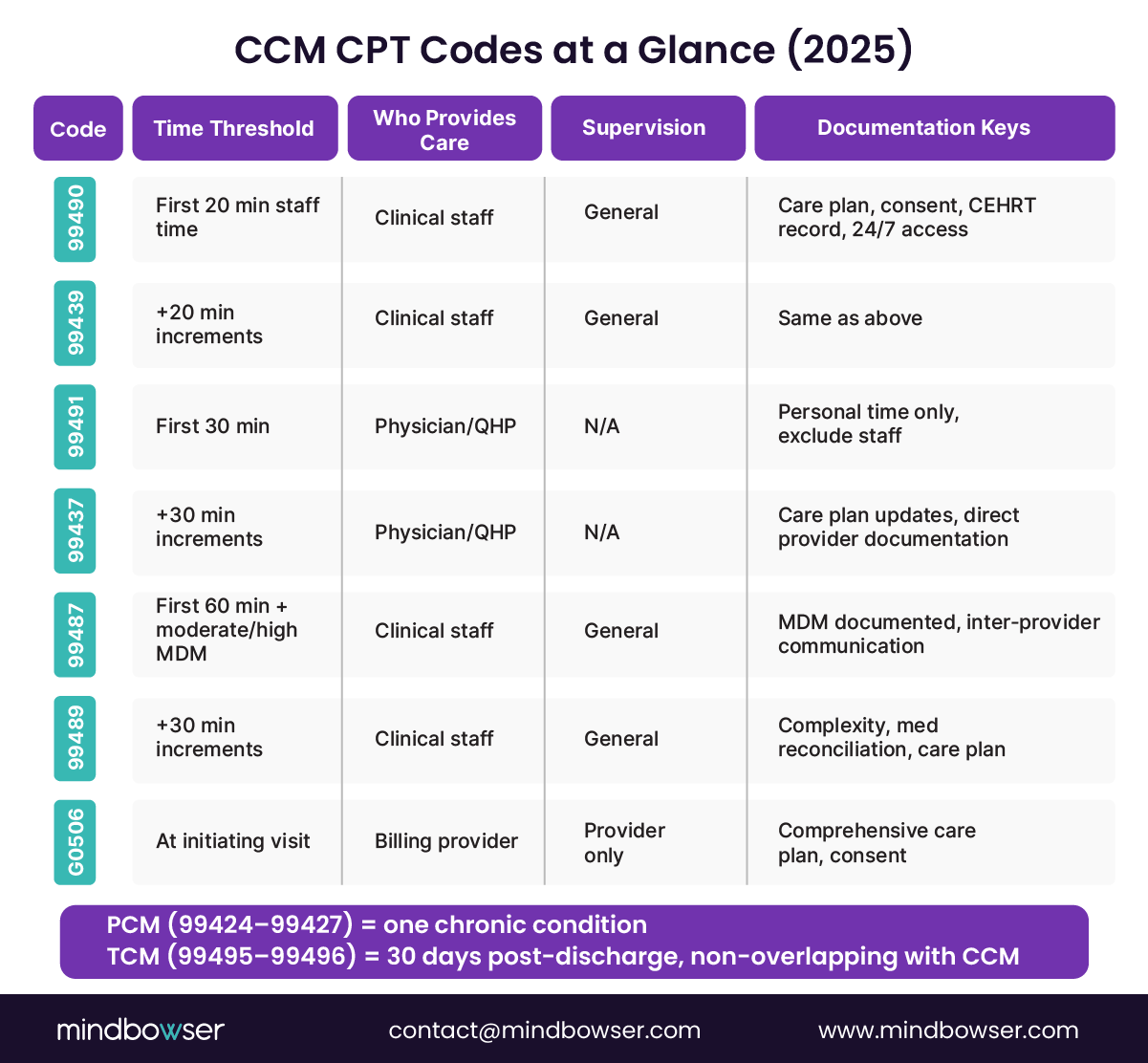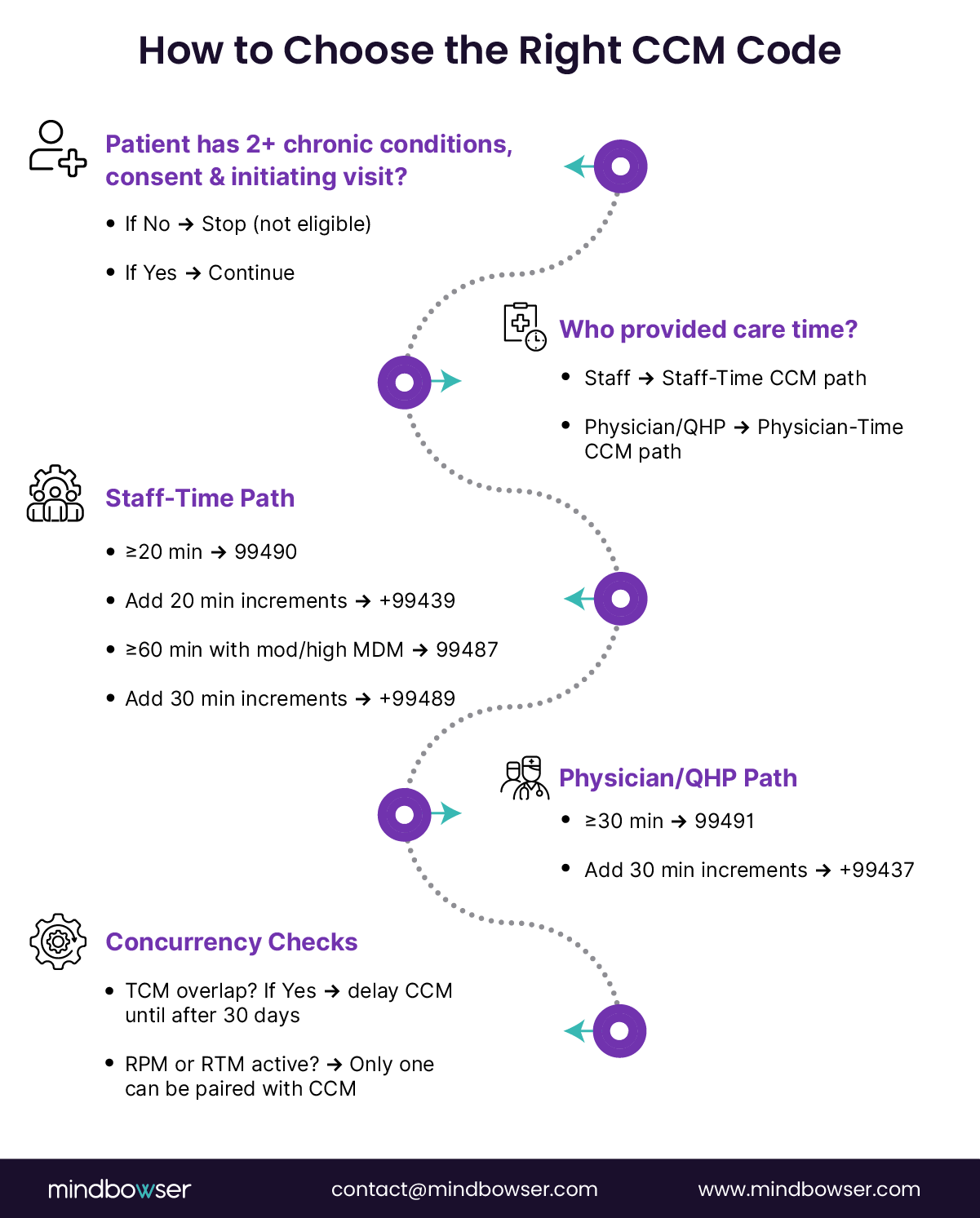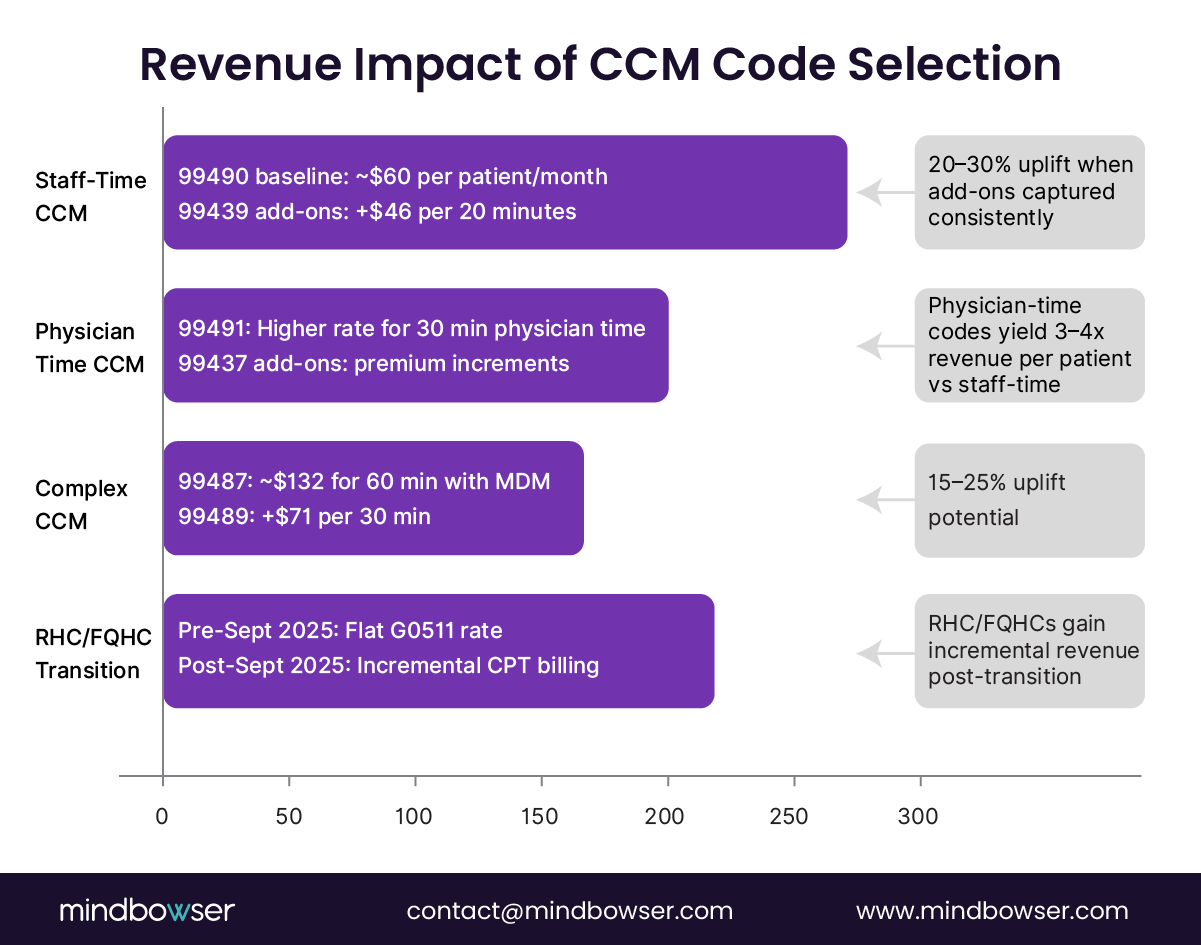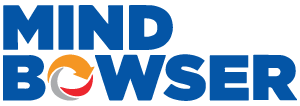Chronic Care Management (CCM) billing in 2025 requires precise code selection across multiple CPT variants. Differences in time thresholds, who can bill, and supervision requirements create room for costly errors. This guide compares all CCM CPT codes side by side, provides real claims examples, offers a practical selection algorithm, and outlines EHR prompts to help avoid denials. For hospitals and digital health companies, mastering CCM codes is the foundation for scaling value-based care revenue while staying compliant.
Chronic Care Management has become one of the most reliable reimbursement streams for providers working in value-based care. Yet billing remains a stumbling block. The Centers for Medicare & Medicaid Services (CMS) has refined CCM policy for 2025, expanding opportunities for Rural Health Clinics (RHCs) and Federally Qualified Health Centers (FQHCs) while tightening rules around concurrency with Transitional Care Management (TCM), Remote Patient Monitoring (RPM), and Remote Therapeutic Monitoring (RTM).
For executives, the challenge is twofold. First, coding teams must understand the subtle differences between staff-time CCM, physician-time CCM, and complex CCM. Second, EHR workflows must capture time and documentation thresholds in real time. Miss either step, and denials or audit risks follow.
This blog breaks down every CCM code variant, shows how claims are processed in real-world settings, and equips leadership teams with a structured algorithm to ensure the right code is billed every time. Drawing from recent CTO interviews, we also highlight how EHR prompts and automation can reduce errors before they reach payers. Finally, we tie each step to Mindbowser’s experience helping hospitals and digital health startups build platforms that streamline CCM, integrate with EHRs, and deliver measurable ROI.
CCM now exists in three main lanes:
Together, these codes ensure flexibility but also increase the risk of misclassification. Coding teams must evaluate not only the time spent but also the complexity and who provided the service.
Several policy shifts will shape coding decisions this year:
One of the most significant changes applies to rural and underserved providers. Until September 30, 2025, RHCs and FQHCs can continue using the general care management code G0511. After the transition, they must adopt individual CPT add-on codes. This change better aligns reimbursement with patient complexity rather than time, but requires early workflow adjustments to avoid revenue disruption.
Related read: Chronic Care Management Billing in 2025: From CPT Codes to APCM Strategy
Understanding the differences among CCM CPT codes is crucial for ensuring compliance and accurate reimbursement. Below is a detailed breakdown of each family of codes with emphasis on how time, supervision, and billing authority differ.

This code family is the entry-level CCM and is most frequently used by practices that rely on nurse care managers or medical assistants under supervision.
These codes are appropriate when physician engagement is high, such as with medically complex patients or when provider input is central to ongoing decision-making.
Complex CCM codes recognize the greater burden of care coordination and reward providers for higher acuity patient populations.
Although optional, G0506 ensures fair reimbursement for the extra work required when a provider builds a detailed, personalized plan.
Practical Takeaway:
Think of CCM coding like three lanes on a highway:
Our team has helped hospital networks and digital health startups design scalable, compliant CCM workflows that cut audit risk and drive measurable growth.
While tables and rules explain what should happen, real-world claims reveal how payers respond. The following anonymized case studies illustrate how various CCM codes are applied in practice.
📌 Key Insight: Real claims confirm that documentation and timing rules matter as much as code selection. Denials most often occur when staff minutes are double-counted, when TCM overlaps with CCM, or when complexity is claimed without MDM documentation.
Providers often struggle to decide whether to bill non-complex CCM, complex CCM, or physician-time CCM. To make this process repeatable, it is helpful to use a structured algorithm that aligns patient eligibility, time thresholds, and policy rules with the correct CPT code.

Ensure that increments are not double-counted. If the minimum time threshold is not met, the code should not be billed.
When applied in an EHR or practice management system, the algorithm can be visualized as a simple decision tree:
📌 Key Insight: The algorithm protects providers from underbilling by ensuring every captured minute is matched to the correct code, while also preventing denials caused by concurrency errors. When embedded into EHR workflows, it serves as a guardrail that reduces staff training needs and enhances coding accuracy.
Mindbowser helps you translate real-world workflows into automated, audit-ready billing logic inside your EHR — so every minute counts and every claim gets paid.
Even with clear rules and algorithms, many denials stem from missed documentation or overlapping codes. Embedding EHR prompts within the care management workflow reduces these risks and ensures billing teams capture every eligible dollar without creating audit exposure.
Mindbowser’s accelerators can operationalize these guardrails:
📌 Key Insight: By shifting compliance from staff memory to system prompts, organizations reduce denials, shorten onboarding time for new care managers, and scale CCM programs without sacrificing accuracy.
For CFOs and revenue cycle executives, CCM coding is more than a compliance exercise. It represents a scalable, recurring revenue stream that can offset staffing costs, reduce readmission penalties, and strengthen value-based care contracts. The financial opportunity grows when organizations apply the correct codes consistently and align them with patient complexity.

📌 Key Insight: For finance leaders, CCM is no longer just a compliance program. It is a recurring revenue stream that can fund care coordination teams, reduce readmissions, and improve payer negotiations. Correct coding, supported by structured EHR workflows, is the lever that turns compliance into profitability.
Related read: How Much Does Medicare Pay for Chronic Care Management in 2025
Launching or expanding a CCM program requires disciplined execution. Coding knowledge is not enough. Practices must embed workflows, train staff, and hardwire compliance from day one. This playbook outlines the first 90 days in three phases, followed by governance guardrails that protect revenue.
📌 Key Insight: Programs that treat CCM as a one-time billing exercise often falter. Sustainable success stems from integrating patient attribution, consent, care planning, and audit controls into routine operations, backed by ongoing staff coaching and executive oversight.
Related read: CCM Audit Risk & Protection: A Compliance Playbook for 2025
Hospitals and digital health startups often understand the codes but struggle with execution. Mindbowser bridges this gap by combining engineering depth, compliance rigor, and proven accelerators that make CCM coding repeatable and audit-ready.
📌 Key Insight: Mindbowser does not just explain CCM codes. We operationalize them with technology, compliance frameworks, and real-world ROI outcomes. Our client work demonstrates that the right combination of workflow automation and EHR integration transforms CCM from a billing challenge into a sustainable revenue stream.

Chronic Care Management in 2025 is not just about knowing CPT codes. It is about applying the correct code at the right time, backed by structured documentation and error-proof workflows. The difference between 99490 and 99487, or between 99491 and 99437, may seem subtle, but for payers and auditors, these details determine whether a claim is reimbursed or denied.
For hospitals and digital health startups, the path forward is clear. Coding accuracy protects compliance, while consistent time capture unlocks recurring revenue streams that can fund care coordination teams. As the transition for RHCs and FQHCs takes effect, and as APCM expands value-based reimbursement models, mastering CCM codes becomes both a financial and strategic necessity.
Mindbowser has shown, through its client work and accelerators, that technology can automate these guardrails. From real-time EHR prompts to decision-tree coding algorithms, organizations can eliminate denials, scale care management programs, and strengthen their position in value-based contracts.
📌 Final Insight: CCM codes are not just billing artifacts. They serve as levers for operational efficiency, financial sustainability, and enhanced patient outcomes. The organizations that treat them this way will be the ones that thrive in the next era of value-based care.
No. Non-complex CCM (99490) and complex CCM (99487) cannot be billed for the same patient in the same month. Practices must choose based on the patient’s complexity and the time documented. Attempting to bill both will result in denials, and in an audit, it can trigger compliance risks.
Yes, but only if the time periods do not overlap. TCM (99495 or 99496) covers the first 30 days after discharge. CCM may begin after day 30. If CCM time is logged during the TCM period, payers will deny the claim. EHR prompts should flag these overlaps before submission to ensure accuracy.
Only the physician or qualified health professional can count personal time toward 99491 and its add-on 99437. Staff time cannot be included. These codes are valued higher because they reflect direct provider involvement in care management. Practices should ensure that documentation distinguishes staff activities from those of physicians or QHPs.
No. G0506 is optional and billed only when the practitioner personally creates a detailed care plan during the initiating visit. It provides additional reimbursement for the upfront complexity of establishing the plan. CCM services may still be initiated without G0506, as long as the patient has provided consent and eligibility has been documented.
Until September 30, 2025, Rural Health Clinics and Federally Qualified Health Centers can continue using G0511 for CCM services. After this date, they must transition to standard CPT codes such as 99490, 99439, 99487, and 99489. CFOs and billing teams should prepare for the change by updating workflows and training coders in advance.

We worked with Mindbowser on a design sprint, and their team did an awesome job. They really helped us shape the look and feel of our web app and gave us a clean, thoughtful design that our build team could...


The team at Mindbowser was highly professional, patient, and collaborative throughout our engagement. They struck the right balance between offering guidance and taking direction, which made the development process smooth. Although our project wasn’t related to healthcare, we clearly benefited...

Founder, Texas Ranch Security

Mindbowser played a crucial role in helping us bring everything together into a unified, cohesive product. Their commitment to industry-standard coding practices made an enormous difference, allowing developers to seamlessly transition in and out of the project without any confusion....

CEO, MarketsAI

I'm thrilled to be partnering with Mindbowser on our journey with TravelRite. The collaboration has been exceptional, and I’m truly grateful for the dedication and expertise the team has brought to the development process. Their commitment to our mission is...

Founder & CEO, TravelRite

The Mindbowser team's professionalism consistently impressed me. Their commitment to quality shone through in every aspect of the project. They truly went the extra mile, ensuring they understood our needs perfectly and were always willing to invest the time to...

CTO, New Day Therapeutics

I collaborated with Mindbowser for several years on a complex SaaS platform project. They took over a partially completed project and successfully transformed it into a fully functional and robust platform. Throughout the entire process, the quality of their work...

President, E.B. Carlson

Mindbowser and team are professional, talented and very responsive. They got us through a challenging situation with our IOT product successfully. They will be our go to dev team going forward.

Founder, Cascada

Amazing team to work with. Very responsive and very skilled in both front and backend engineering. Looking forward to our next project together.

Co-Founder, Emerge

The team is great to work with. Very professional, on task, and efficient.

Founder, PeriopMD

I can not express enough how pleased we are with the whole team. From the first call and meeting, they took our vision and ran with it. Communication was easy and everyone was flexible to our schedule. I’m excited to...

Founder, Seeke

We had very close go live timeline and Mindbowser team got us live a month before.

CEO, BuyNow WorldWide

Mindbowser brought in a team of skilled developers who were easy to work with and deeply committed to the project. If you're looking for reliable, high-quality development support, I’d absolutely recommend them.

Founder, Teach Reach

Mindbowser built both iOS and Android apps for Mindworks, that have stood the test of time. 5 years later they still function quite beautifully. Their team always met their objectives and I'm very happy with the end result. Thank you!

Founder, Mindworks

Mindbowser has delivered a much better quality product than our previous tech vendors. Our product is stable and passed Well Architected Framework Review from AWS.

CEO, PurpleAnt

I am happy to share that we got USD 10k in cloud credits courtesy of our friends at Mindbowser. Thank you Pravin and Ayush, this means a lot to us.

CTO, Shortlist

Mindbowser is one of the reasons that our app is successful. These guys have been a great team.

Founder & CEO, MangoMirror

Kudos for all your hard work and diligence on the Telehealth platform project. You made it possible.

CEO, ThriveHealth

Mindbowser helped us build an awesome iOS app to bring balance to people’s lives.

CEO, SMILINGMIND

They were a very responsive team! Extremely easy to communicate and work with!

Founder & CEO, TotTech

We’ve had very little-to-no hiccups at all—it’s been a really pleasurable experience.

Co-Founder, TEAM8s

Mindbowser was very helpful with explaining the development process and started quickly on the project.

Executive Director of Product Development, Innovation Lab

The greatest benefit we got from Mindbowser is the expertise. Their team has developed apps in all different industries with all types of social proofs.

Co-Founder, Vesica

Mindbowser is professional, efficient and thorough.

Consultant, XPRIZE

Very committed, they create beautiful apps and are very benevolent. They have brilliant Ideas.

Founder, S.T.A.R.S of Wellness

Mindbowser was great; they listened to us a lot and helped us hone in on the actual idea of the app. They had put together fantastic wireframes for us.

Co-Founder, Flat Earth

Mindbowser was incredibly responsive and understood exactly what I needed. They matched me with the perfect team member who not only grasped my vision but executed it flawlessly. The entire experience felt collaborative, efficient, and truly aligned with my goals.

Founder, Child Life On Call

The team from Mindbowser stayed on task, asked the right questions, and completed the required tasks in a timely fashion! Strong work team!

CEO, SDOH2Health LLC

Mindbowser was easy to work with and hit the ground running, immediately feeling like part of our team.

CEO, Stealth Startup

Mindbowser was an excellent partner in developing my fitness app. They were patient, attentive, & understood my business needs. The end product exceeded my expectations. Thrilled to share it globally.

Owner, Phalanx

Mindbowser's expertise in tech, process & mobile development made them our choice for our app. The team was dedicated to the process & delivered high-quality features on time. They also gave valuable industry advice. Highly recommend them for app development...

Co-Founder, Fox&Fork
